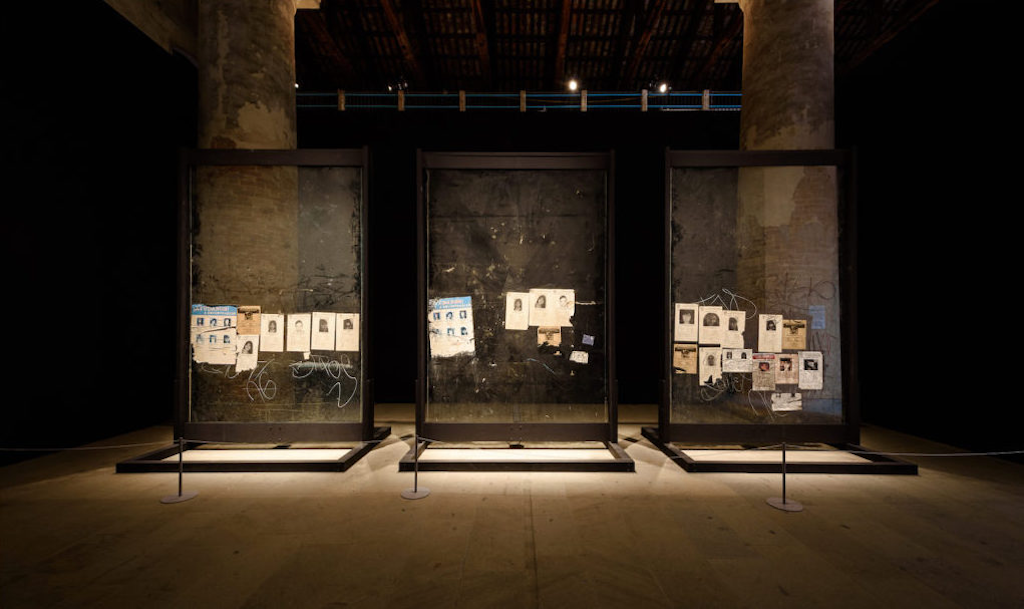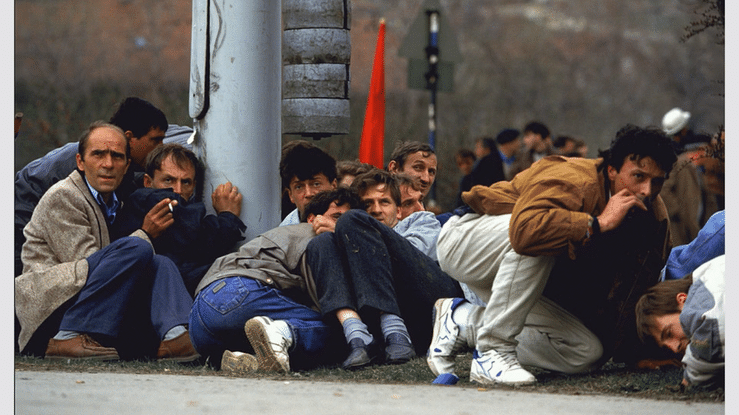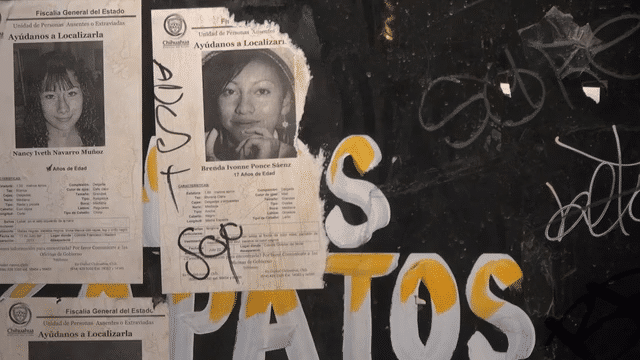Visualizing the Rights of the Dead: Photography after Arendt
Cecilia Sjöholm
Arendt's Photographic Right to Have Rights
Hannah Arendt argued that the principle of human rights formulated during the Enlightenment has proven incompatible with modern ideas of national sovereignty. In Arendt’s view, sovereignty presumed compliance between citizenship and rights: without citizenship, no rights. Such logic has reduced stateless humans, as well as prisoners and victims of war crimes, to the site of naked life. It is not only the citizenship but the very humanity of such groups that is at stake: “the world found nothing sacred in the abstract nakedness of being human,” Arendt wrote.{1} “A man who is nothing but a man has lost the qualities which make it possible for other people to treat him as a fellow-man.”{2} The resulting condition is one of absolute exposure. No natural law defined by philosophy, such as the prohibition of killing, is capable of overcoming the orders of modern lawmaking. No philosophical concept, moreover, including the idea of the proletariat, offers much but reification of naked life as a social category.
Responding to this lack, Arendt argued that the principle of human rights ought never to be founded on a specific content but that the principle itself should be displaced by “the right to have rights.” This means that all—with or without the definition as human—should have the right to belong to an organized political community.{3} Arendt based her assertion on the Roman tradition, where the law is an outcome of the political negotiations of the res publica: the public space of political life. Greek lawmaking was no less important. It presented law as a pre-political condition for the production of sovereign space. Law is like a wall or barrier: “this wall-like law was sacred, but only the enclosure was political.”{4} In other words, the law is a condition for that which takes place in a political community. But a political community is not a nation, or a state. It is a space which makes lives visible.
Today, the camera is a decisive tool for the appearance of those who are not readily recognized to possess rights, those who have been excluded, banned, or otherwise denigrated— refugees, victims of war. Susie Linfield is one of many scholars who describes an intrinsic relation between the widespread images of human suffering: photojournalism has “globalized our consciences.”{5} Conscience or empathy, however, is not the issue as Arendt might see it; the question is rather how we are to conceive of the rights of the bodies depicted. Documentation of war in the work of the photographers Ron Haviv and Nina Berman, for example, shows that the camera is a provisional and imperfect tool for denoting legal standing. As Ariella Azoulay has argued, we must today talk of an extended, photographic citizenry, a “civil contract of photography,” which serves as an alternative to the visual regimes of modern power. Photography offers the potential, in its widespread use, to overcome the distinctions imposed by national sovereignty and subjection.“The civil contract of photography,” Azoulay writes, “enables citizens and noncitizens alike to produce grievances and claims that otherwise can’t be seen and to impose them by means of, through, and on the citizenry of photography.”{6}
Her work prompts us to consider the potential judgment made possible by aesthetic perception. We need to conceive of the aesthetic not only in our apprehension of an image but by way of accompanying narratives and counter-images. Judgment necessitates recognition that an image exists in the context of a political community. The camera may be fully capable of making rights appear, not only in the sense that it may depict obvious injustices and violations, but insofar as it can pose questions of who counts as human and who is voided of worth and symbolic value. One may, in other words, understand the debate over the right to have rights via an aesthetic framework that determines the value of life, whether it is imbued with political meaning or left naked, unprotected beyond the horizon of full humanity.
To this, however, we must add the complicated fact that it is not clear how we are to treat the rights of bodies that are no longer living. How are we to perceive the role of the dead in conceptions of political agency? Both Arendt and Giorgio Agamben have foregrounded a critical distinction between life considered as zoe, that is biological fact, or and life considered as bios, the life of the individual and political community.{7} To Agamben, naked life, or zoe, is the kind of life that is relegated at will to the sovereign power. Yet even naked life, in Arendt’s framework, must have the right to have rights. The idea conveys a certain inalienability: we cannot abide the murder or mutilation a living body, no matter to whom the body belongs, no matter its gender or its origins.
Sometimes, however, the rights of a body itself, devoid of life, are also called into question. Sometimes the dead evince the rights they held, or should have held, at the time they were killed. Surveying the use of lifeless bodies in artistic works—John Duncan’s cadaver performances in counterpoint with Teresa Margolles’ investments in the full humanity of disappeared persons—helps us to develop ideas about the relationship between appearance, law, and aesthetic judgment. While Duncan’s work renders the body a mere object, Margolles’ seeks to make the past lives of the dead appear to us.
****
Photography and the Pain of Others
The Universal Declaration of Human Rights was forwarded by the United Nations in 1948. It states that everyone has the right to life, liberty, and security, that no one should be subjected to torture, or to cruel, inhuman, or degrading treatment or punishment, and that everyone should be recognized as a person before the law. War crimes, in turn, have been defined by international law ever since the nineteenth century, conceived to protect civilians and prisoners of war against torture, sexual violence, and dispossession. The laws against war crimes and the Declaration state plainly that human beings should be protected by the rule of law and thus granted absolute dignity. Sharon Sliwinski has contended that the Declaration was partly motivated by the images that reached the world community with the opening of Nazi concentration camps after the Shoah. As Sliwinski argues, the history of human rights is a “richly illustrated one.” In the long postwar period, much of the discussion around human rights focused on the ethical implications of photography.{8} In On Photography, Susan Sontag highlighted the relation between suffering and empathy: photographic images imply “a grammar, and even more importantly, an ethics of seeing.”{9} At the same time, Sontag argued that photography and its reception constitute an act of “non-intervention” — indeed our perception of an image connotes our complicity with the world as it is. Ever since Sontag, we have been discussing various notions of ethical responses to photographic images of cruelty, suffering, and loss. We ask whether it is morally acceptable to look upon dead bodies. Is it exploitative, or can it awaken our desire to act in the name of just causes? Susie Linfield, following Sontag, has argued that photographers cannot show human rights, only “what the absence of such rights does to a person.”{10} Over the last few years, however, there has emerged an abiding interest in the relation between photography and rights, thus shifting our perspective from an ethics of seeing to a politics of visuality.
As both Charlotte Klonk and Ariella Azoulay have demonstrated, today everyone is a participant in the world of images. We share responsibility for what is shown across mediated platforms and relationships.{11} We participate in the reception of videos that document beheadings, violations, and desecrations. In sharing responsibility, furthermore, we displace the individual act of seeing with an attention to the world of photography as a mutual civic context. If we look at the body of a beheaded victim, our own emotions are, in other words, not the pivotal issue. What is at stake is rather the fact that a violation against international law may have been committed, and that we, as spectators, in the act of consuming these images, are made complicit in the very violation. Why? We see the images and in seeing them may imbibe the spectacle of violence as passive voyeurs. As photos become canonized, furthermore, they attain a certain distance. Sontag refers to this distance as an “aestheticized” response—we use judgment to cleave our instinctual reactions and thus to absolve ourselves of responsibility for the images. But this idea derives from a rather narrow definition of aesthetics. As Azoulay has argued, by contrast, images are aesthetic in the sense that they are produced and seen within a series of overlapping visual and political traditions. We may add to this that while the original conception of “aesthetic judgment,” to be found in Immanuel Kant’s Critique of Judgment, depends on “disinterestedness”—the freedom of the sensing and thinking subject in relation to the object perceived—this necessitates some recognition of what the image fails to disclose.
 Figure 1. Paintings of a dun horse and the bird-headed ithyphallic figure or the “Dead-man” at Lascaux.
Figure 1. Paintings of a dun horse and the bird-headed ithyphallic figure or the “Dead-man” at Lascaux.
To Georges Bataille, what any image discloses is a play of life and death. In his speculations on the cave paintings in Lascaux, Bataille argued that an exuberant joy of life expressed in the paintings (sometimes called the birth of art) induced a fear of death, which was in turn looked upon with awe. To Bataille, the faces of the dead represented an original version of a sacred object.{12} It is not by chance that so many images in contemporary global society evoke violence. Can the reverse also be true? Do images of violence provoke questions about the protection of life? The Norwegian state tried to stop the spread of images of women who were beheaded by ISIS; these acts of violence had been performed precisely for the sake of their own documentation and dissemination. The image of death—or more precisely the fact of death relayed in images—was displaced by the functional and thus political import of the image’s circulation.
A photograph, in short, cannot be reduced to what occurs within the frame, nor to the subject who views the image. What we see is not an act perpetrated against this or that person, subject, people, or identity, but an enveloping situation which implicates multiple parties. We learn to conceptualize and reflect critically upon our own participation in viewing the image. Following Arendt, we might see ourselves as in this way already embedded in a world of appearances. To Arendt, the spectator who seeks to make a judgment engages the world through a pose of disinterestedness, but importantly this neutrality does not disarm the spectator but guides her preparedness to act.{13} This means that aesthetic judgment, in an Arendtian reading, has to do with a sense of sharing and potentiality within the context of a dynamic political community. In other words, the process of aesthetic perception in this context does not connote a moral distance, as Sontag is assuming, but a dynamic set of perspectives, choices, and investments.
****
Photography and War Crimes
Given the extraordinary spread of images from war zones and other situations of crisis, our treatment of images depicting the violation of human bodies has become a pressing juridical issue. Yet it remains difficult to determine how a court will act. An image may convey one thing but its determining social context may suggest another. It has been argued, for example, that the war in former Yugoslavia produced a new role for the image of war, since photographs were admitted as evidence in war crimes trials.{14} Litigators employed photographs by the photographer Ron Haviv, who had become internationally celebrated for his documentation of killings, desecrated bodies, and the erection of concentration camps. Haviv’s images were submitted as forensic evidence to the International Criminal Tribunal in the former Yugoslavia’s case against Arkan in 2000. Haviv himself abstained from giving testimony in order to avoid endangering war photographers in the future.{15} The images would presumably speak for themselves. Despite their evidentiary value, however, the images quickly became subject to debate: a photograph of the Serbian concentration camps in Trnopolje, for example, was questioned because it was said to evoke the Shoah and thus seemed to demand an implicit comparison.{16} The photograph’s unintended reference, while giving meaning to what it contained, potentially obstructed its purchase in its immediate context of the trial. If a photograph points too much to its referent, it risks reducing the complexities of what it shows. The resulting ambiguities threaten the notion that photographic images contain verifiable truths. The supposed political neutrality of the document, which is vital to its evidentiary purchase in court, must be rethought.{17} Haviv’s critics allege that the photographer was an agent at the scene, rather than a mere onlooker unaware of his influence on actual events.{18}
It is all but impossible to conceive of any photographer, or any photograph, that does not represent some kind of position, agency, or referential field. Sometimes these aspects of the photograph are not even conscious choices. Azoulay has argued that photographs of the rubble that covered the mass graves in Berlin in 1945 disclosed certain facts that were not directly shown—the images were of an effort by Nazi troops to destroy corroborating evidence.{19} The images imply that war crimes had taken place, but do not identify the nature of these crimes. The photographs contain meaning without eliciting pity, empathy, or other emotional responses. In this way they could be said to perform their politics rather than to document a specific political activity.
Consider again the context of the Yugoslav Wars, during which sexual violence came to the attention of the world as a weapon of war. This was the first time that international law recognized rape as a crime against humanity, following the Geneva Convention.{20} This development occurred in light of the widespread reporting the stories of rape survivors, which were in turn collected and submitted to the courts by human rights organizations, reporters, and photographers. The making visible of sexual violence through the documentation of storytelling about rape drew the world’s attention not only to the suffering that took place but to the trauma experienced by those who were affected. In the work of photographer Nina Berman, the sharing of personal narrative was shown to bear an equal weight to the photograph itself. Berman’s work from the war in Yugoslavia consisted in documenting not only individual victims, but composite stories which were presented in courts and human rights commissions. In this sense, what is depicted is not helplessness, but humanity hitherto denied. The work made legible the right to have rights and did so within a legal framework that made justice possible.{21}
Photographs by Ron Haviv, taken between 1992 and 1996 during the Bosnian war. Images published in BLOOD AND HONEY: A BALKAN WAR JOURNAL (2000).
****
When the Dead Cannot Speak for Themselves
But how are we to address rights of bodies in art and photography when no law is applicable? And how are we to deal with a notion of rights that cannot be claimed by the victim, but the body that has passed beyond even the state that Arendt and Agamben call zoe, or mere biological being? One example of a work that presents a body without rights in a way that appalled many can be found in the work of American artist John Duncan. At the end of the 1970s, Duncan bought a corpse in Mexico, had sex with it and recorded the sounds. (In addition to the sexual act, Duncan had a vasectomy performed on himself and recorded these sounds as well). The resulting sonic traces are at the core of the work Duncan titled Blind Date. The sounds are supplemented by a photographic image. Duncan explained the motivations Blind Date in this way:
I wanted to punish myself as thoroughly as I could. I’d decided to have a vasectomy, but that wasn’t enough: I wanted my last potent seed to be spent in a dead body. I made arrangements to have sex with a cadaver. I was bodily thrown out of several sex shops before meeting a man who set me up with a mortician’s assistant in a Mexican border town.{22}
On his webpage, Duncan describes his art as an experience of a pure overflow of life, spilling into the awe of the dead. This is an idea of aesthetics perhaps inspired by Bataille’s reflection on the awesome power waged by images of death—but Bataille took us back to the cave paintings of Lascaux, and did not discuss the bodies of his time. Duncan’s work was different.
Decades later, when Duncan was an artist in residence at IASPIS in Stockholm, the institution’s board learned about the work, which was still advertised at the artist’s website, and he was thrown out of the program. This caused an uproar among many artists in Stockholm. The resulting Committee of Support for John Duncan’s Stay in Sweden arranged an evening at a performance venue, where it lamented that Duncan had been “severely humiliated by the board of IASPIS” and would have to “survive the next five months without a contract.”{23} Eventually, the board settled financially with Duncan, although he was not allowed back into the program. (He returned in 2008 with a show, The Gauntlet, on perception, exposure, and seeing.{24}) Duncan’s defenders found Blind Date challenging and provocative, ultimately mounting a defense of the artist’s right to free expression. But these defenders had nothing to say about the rights of the body of the dead woman. Not once were the possible legal ramifications of his act of using a corpse brought into discussion. The corpse of an anonymous woman was thus presented again as affording no civic or political attention. The woman, or her body, were denied recognition. Certainly such denial has much to do with gender, race, and nationality: the corpse of an anonymous Mexican woman was offered no value beyond its relation to a celebrated American artist. There is a morbid irony involved in the support of the group’s appeal to Duncan’s humiliation by the IASPIS, and in the expression of fear over how Duncan would survive the next months without remuneration.
The absent presence of another’s death (and thus a recognition of her life) appears in related artistic practices to quite different ends. Teresa Margolles has exhibited body parts and images of victims which had hitherto been suppressed from public view. Through her employment at a morgue, Margolles gained access to human remains that told of criminal violence. Her work thus offered a kind of social critique. For example her Cards for Cutting Cocaine (1998) were produced for the upper-class kids of Mexico City who employ the cards to cut up and handle the drug. Her work Dermis (1995) consists of a bed sheet that shows the bloody stains of two embracing lovers who had taken their own lives. What remained on the sheet was the direct trace of two dead bodies. Formally, Margolles’ use of visual and material traces may not be so different from Duncan’s use of sound, but the governing context could not be more different: Margolles is herself a Mexican woman working within the idiom of loss and recovery which characterizes life in the country for such a long time and which has in some sense been exacerbated by the cavalier treatment of disappeared bodies by Duncan. In his book on contemporary Mexican art, the critic Ruben Gallo has stated that the traffic in bodies and body parts has become a dimension of Mexican life especially since the liberalization of the nation’s economy in the 1990s.{25} As Gallo argues, Margolles’ work must be understood from such a point of view. He points out that although Margolles has drawn criticism from international art audiences, this has seldom been the case in Mexico. Margolles does not degrade the bodies she uses, but evokes a sense of their personal histories and thus the affordance of recognition through the paradigm of rights. The violence that is evoked in Margolles’ work is thus formulated within a negotiated political community. This way, the young women will not only be remembered as objects of love and affection, but through legal recompense for their unjustifiable deaths.
 Figure 2. Teresa Margolles, LA BÚSQUEDA (THE SEARCH), 2014, Sound installation. Intervention with sound on glass panels transported from the historical center of Ciudad Juárez, Mexico. The audio was recorded from the train that divides the city, and
transformed into low frequencies. Installation view, Arsinale, Venice
Biennale, 2019. Photo by Andrea Avezzù. Courtesy of the artist and James Cohan, New York.
Figure 2. Teresa Margolles, LA BÚSQUEDA (THE SEARCH), 2014, Sound installation. Intervention with sound on glass panels transported from the historical center of Ciudad Juárez, Mexico. The audio was recorded from the train that divides the city, and
transformed into low frequencies. Installation view, Arsinale, Venice
Biennale, 2019. Photo by Andrea Avezzù. Courtesy of the artist and James Cohan, New York.

Margolles’ work is always indexical, and always metonymic: she would never exhibit a full corpse, only memories of it. Her photographic installation at the 2019 Venice Biennale, La Busqueda (The Search), originally shown in 2014, demonstrates this quality. At the forefront are the faces of young Mexican girls and women, their images appearing upon the xeroxed copies of MISSING Posters that adorn city walls and marketplaces. Margolles has situated these posters upon glass panels, all of them placed in a dark room. The installation includes a sound, recorded from a train that cuts across Ciudad Juárez, implying also the location where the girls went missing. What we witness is the result of the violent narcotics trade with a specific relation to the city. The women and girls are casualties of that violence. As audiences enter the dark room, they become rattled by the sound of the trains. The sense of place immerses the audience as the faces of the women are illuminated. These are not anonymous bodies, the work shows, but persons with names, faces, backgrounds, ages. Each has a day on which she went missing. Margolles uses these materials to speak of the victims who have never been afforded rights but who, through her work, are made to appear as subjects. Margolles could be said to bring the bodies from a state of zoe to that of bios: they are no longer merely a number in a tale told many times about the disappeared women of Ciudad Juárez, but individual subjects with personal histories. The work provokes the audience to imagine the lives of young women lost to violence. Not to affect a moral instinct, but to redress the violations of individuals. Making the faces of these girls appear is an expression of the right to have rights: to be honored as the victims of individuated acts of violence, rather than as casual throwaways in a massive, global circulation of trafficked bodies.
Arendt’s evocation of the right to have rights compels us to consider photography and art practices—not simply as evidentiary documentation but as gathering points for narratives, demonstrations, and other kinds of aesthetic elaboration. The circulation of disputed images of violence reveals the generalized complicity of art audiences and institutions. Visualizing the rights of the dead calls us to undo law’s complicity with power in the context of national sovereignty. Our capacity to negotiate such rights needs to develop, bringing the spectator beyond her private sense of morality towards a more distinct sense of what communal responsibility might entail.
Background Video: Teresa Margolles’ La Búsqueda (2014), installed at the Migros Museum of Contemporary Art / Photographs by Ron Haviv, taken between 1992 and 1996, published in Blood and Honey: A Balkan War Journal (2000).
{1} Hannah Arendt, The Origins of Totalitarianism (London: Harvest, 1973), 295-296.
{2} Ibid., 296–297.
{3} Ibid., 296–297.
{4} Hannah Arendt, The Human Condition (Chicago: University of Chicago Press, 1998), 64; see also 194–195.
{5} Susie Linfield, The Cruel Radiance: Photography and Political Violence (Chicago: University of Chicago Press, 2010), 46.
{6} Ariella Azoulay, The Civil Contract of Photography (New York: Zone Books, 2012), 192.
{7} See Hannah Arendt, Between Past and Future (London: Faber and Faber, 1961), 42; and Giorgio Agamben, Sovereign Power and Bare Life, trans. Daniel Heller-Roazen (Stanford, CA: Stanford University Press, 1995), 179–193.
{8} Susan Sliwinksi, Human Rights on Camera (Chicago: University of Chicago Press, 2016), 4.
{9} Susan Sontag, On Photography (New York: Viking, 1977), 1.
{10} Linfield, 37.
{11} See Charlotte Klonk, Terror: When Images Become Weapons (Berlin: Fischer Verlag, 2017); and Azoulay, The Civil Contract of Photography.
{12} Georges Bataille, Prehistoric Painting: Lascaux or the Birth of Art, trans. Austryn Wainhouse (Geneva: Skira, 1955), 31.
{13} See Cecilia Sjöholm, Doing Aesthetics With Arendt (New York: Columbia University Press, 2015).
{14} See Ron Haviv, Blood and Honey: A Balkan War Journal (Brooklyn: TV Books / Umbrage Editions, 2000).
{15} For a discussion on the legal repercussions of these images, see Martin Lukk and Keith Doubt, “Bearing Witness and the Limits of War Photojournalism: Ron Haviv in Bijeljina,” Human Rights Quarterly 37
(2015): 629–636; Ron Haviv, “Response to Martin Lukk and Keith Doubt,” HRQ 38 (2016): 208–210; and Martin Lukk and Keith Doubt, “Response to Ron Haviv,” HRQ 38 (2016), 211–216.
{16} Sliwinski, 124.
{17} Thomas Keenan, “Mobilizing Shame,” South Atlantic Quarterly 103, nos. 2-3 (Spring/Summer, 2004): 435–449.
{18} Lukk and Doubt, 2016.
{19} Ariella Azoulay, “Rape,” in Visual Global Politics, ed. Roland Bleiker (London: Routledge 2018), 237–244.
{20} See for instance Beverly Allen, Rape Warfare. The Hidden Genocide in Bosnia-Herzegovina and Croatia (Minneapolis: University of Minnesota Press, 1996).
{21} Kelly Foster, “Lessons from ’91—Documentary Photography From Ex-Yugoslavia,” Ikon Arts Foundation; see also Nina Berman, “Bosnia Archive,” November 5, 2010.
{22} See John Duncan, Blind Date.
{23} Ingrid Engarås, “Committee of Support for John Duncan’s Stay in Sweden,” March 9, 2002.
{24} See Fargfabriken, “The Gauntlet,” Feb 2, 2002.
{25} Ruben Gallo, New Tendencies in Mexican Art: The 1990’s (London: Palgrave MacMillan, 2004), 116-120.




